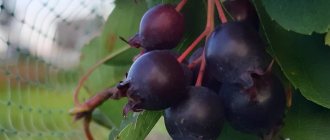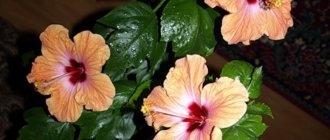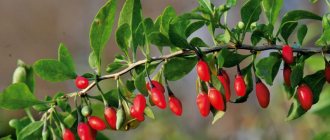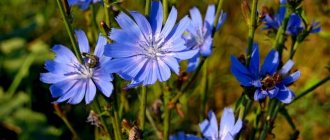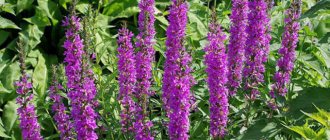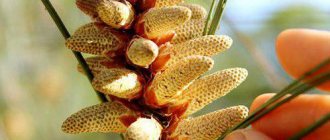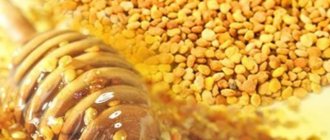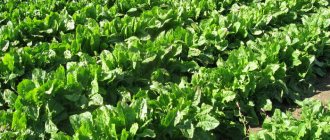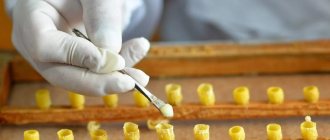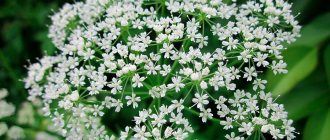Bracken is a beautiful perennial of the Fern class, Dennstedtiaceae family. This beautiful plant is known for not only decorating the garden and home, but also being used for food and to treat a number of diseases. The bracken got its name from its triple fronds that resemble an eagle’s wing. Some people recognize the initials of Jesus Christ on the cut of the stem, so bracken can also be found under the name “Jesus grass.” The fern is widespread in the forests and steppes of Europe, Siberia and the Far East. Here it is regularly collected and stored for future use. In order not to go to the forest for ferns, you can grow beautiful and useful bushes on your own plot. They are quite easy to care for, and the spreading crown develops very quickly.
Here you will learn:
Botanical description
Bracken is a herbaceous perennial plant 30-100 cm high. A powerful root system develops in various directions. The rhizome is located horizontally, from which young shoots appear annually. Vertical shoots go deep into the ground and nourish the plant. They can persist after fires or other disasters. Thanks to such roots, bracken can grow safely in one place for hundreds of years.
At the beginning of spring, young shoots appear from the ground. They are located singly at a distance of 10 cm from each other. The surface of the shoot is bare, and the upper part is first bent in the shape of a snail. Later, leaf blades bloom from it. Double- and triple-pinnate foliage exudes a specific odor. Dense dark green lobes are rounded at the tops. At the base of the lower leaves are nectaries. They exude a sweetish juice that attracts ants.
The fused sori are located as a continuous border along the edge of the sheet and are hidden by the fold of the canvas. The spores ripen by July-August, but they do not appear on the leaves every year. Ripe sporangia open independently and small, round seeds spill out. They are carried by the wind over long distances.
Most botanists consider the bracken genus to be monotypic and include only one species - the common bracken. According to other scientists, there are about a dozen more varieties. They are all quite similar to each other. Most varieties of ferns of this genus are common in the natural environment and are not cultivated.
How does bracken fern reproduce?
Lichens multiply by spores the longest. In summer, brown spores form on the underside of the foliage, within which seeds eventually form. After the embryos mature, they pop out and scatter in the wind. Once on favorable soil, the grain begins to germinate and form a small greenish “cup”. Then, on the reverse side of the germ, male sperm and female eggs are formed. When mating occurs, the seed begins to germinate. At the same time, the stepson takes root deeper. Over the course of several years, the fern forms a mature bush.
Vegetative propagation by shoots occurs when long fluffy arrows are formed. These tall shoots are bent towards the ground and pressed down with stone or moss. This procedure is best carried out in the spring, when the growth of Jesus bracken grass progresses. After some time, the arrow takes root. A fern shoot can be cut off from the mother bush and transplanted to the desired location.
The easiest way to propagate old lichen is by division. In early spring, when the weather is still damp and cool, the fern is removed from the ground. Dense rhizomes are washed with water to remove a lump of soil. Then they are divided into separate shoots, which are transplanted to the desired territory.
Other known types of lichen
The most famous varieties include:
- The common ostrich fern grows well in the sun. Only in hot summers do some leaves fade, so it is better to plant them in the shade. This variety of lichen is also called garden, because it is very popular among gardeners. Reproduces by spores. They appear in autumn on the underside of leaves and are brown in color. The roots spread deep and far from the bush itself, while giving many shoots. Planted in spring. The ostrich loves moisture. This variety of fern reproduces by spores, shoots and division.
- The female kochedyzhnik is most widespread in the northern hemisphere. The leaves are spreading, elliptical in shape with a thin blade. Color ranges from light to dark green. The crown can reach one meter, but at the same time have the appearance of beautiful openwork fans. Mature leaves live only one season; when frost sets in, they wither, but still manage to produce offspring. Unlike the next species, the female nomad grows in small groups or alone. For this reason, it is not used in medicine, because it is difficult to access for large-scale collections.
- The male shield has similar medicinal properties as the female one. Actively used in herbal treatment. Like other types of fern, it has a powerful root system, creeping through the bowels of the earth in different directions from the bush. Reproduces by spores and babies. It reaches a height of 1.5 meters. The leaves are feather-shaped with lacy edges. The plant is poisonous and can cause poisoning if used incorrectly. Not recommended for children under three years of age, pregnant women, as well as for diseases of the liver, stomach, kidneys, heart, anemia, tuberculosis.
- Horsetail is a perennial spore plant of the horsetail family. It reaches a height of 60−70 cm. The stems become spore-bearing in spring, and sterile in summer. It reproduces both vegetatively and by spores. The plant prefers sandy soil, so it is often found in quarries, river banks, fields and forest clearings. Known for its healing properties. But horsetail is poisonous, so dosage must be observed. Useful in the treatment of wounds, ulcers, liver tumors, stomach and intestinal disorders.
- Common centipede is also called viper grass or oak fern. The roots are sweet to the taste and 1 cm wide. Spread by spores that ripen in June-August. Grows on stumps, mosses, rocks. The leaves are evergreen, creeping along the trees. Used in medicine, homeopathy. Used for headaches, gout, and also as an antiseptic, choleretic agent, and laxative.
- Kostenets postenensis is considered a low-growing perennial fern. The height of the plant is only 15 cm. The leaves are oval, triangular or lanceolate. Reproduces by spores. In Russia it grows everywhere, but it is difficult to find this type of lichen. Found in North America. Kostenets prefers limestone soil and rocky surfaces. It often trails along walls, which is why it got its name.
- Salvinia floating is a watery variety of fern. Often used in aquariums. The leaves are attached in pairs to the trunk. Salvinia is unpretentious to temperature changes and feels comfortable in both soft and hard water. It reproduces by spores found under the leaves. When ripe, the embryos sink to the bottom, then in the spring they rise to the surface in the form of an independent plant.
Reproduction methods
Bracken is propagated by spores or by dividing the bush. To collect spores, you need to cut off a leaf with sori in September, dry it and scrape the spores onto a sheet of paper with a spoon. After drying, the seed material is placed in a paper bag and stored until winter. In January, boxes with peat soil are prepared. The soil is moistened, and then small seeds are poured onto the surface. The pot is covered with glass and placed in a warm, bright room. Crops should be ventilated and sprayed daily. After 8 weeks, the surface of the soil will be covered with green moss. Now the cover can be removed so that oxygen can better flow to the seedlings. Grown seedlings are transplanted into separate small pots. In April-May, bracken is ready to be transplanted into open ground.
Dividing the bush is considered a simpler and more effective method of propagation. An adult fern has a developed rhizome, which quickly recovers after pruning and replanting. In mid-spring, when regular frosts are a thing of the past, you should dig up the bracken rhizome. It is divided into sections with 1-2 buds. The cuttings are treated at the cutting sites with crushed charcoal and immediately planted in moist soil. In the natural environment, any part of the rhizome can sprout when dug up, so bracken in agriculture is considered a difficult to eradicate weed. This genus of fern cannot be propagated using cuttings.
Diversity of ferns in nature
In total, there are approximately 300 genera and 10 thousand species of ferns in the plant world. Some of them grow independently, and some exclusively on other trees. Ferns have a developed root system, and the plant itself can be from several centimeters to several meters.
It will take a lot of time to list all the types of ferns, because each of them differs in appearance and in the necessary growing conditions.
In the climate of our country, the most common are:
- Common bracken.
- Common ostrich.
- Female Kochedyzhnik.
- Shieldweed.
- Nephrolepis.
Common bracken reaches a height of 70 cm; it grows on dry, poor soils. The name comes from the similarity of the fern leaves with the feathers of an eagle; the root system is well developed and branched. For animals, bracken is a poisonous plant, but by people it is widely used in folk medicine and even cooking.
The common ostrich or ostrich feather also has similar properties to ostrich feathers. Lush leaves grow one and a half meters in length. They open only in spring, in warm weather; in the cold season, the leaves curl up into a cocoon.
The root system goes deep into the ground, so when growing ostrich at home, the soil must be periodically mulched and loosened.
Female Kochedyzhnik:
- It is distinguished by dissected leaves; depending on the variety, the height of the fern can vary from 30 to 70 cm.
- The rhizome is thick and shallow.
- Without transplantation, the nomadic plant can survive for more than 10 years.
Male fern (shield fern):
- It has one legend: it was believed that this plant served as a human shield, protecting him from grief and poverty.
- Its rhizome is powerful, thick, and grows obliquely.
- The rhizome rises above the ground, it is covered with multiple dark-colored scales and leaf petioles; there is no above-ground stem.
Nephrolepis is the most common fern grown at home. It is unpretentious in cultivation; depending on the type and variety of nephrolepis, the appearance of the frond will differ. The plant has rather long light green decorative leaves. At the bottom of the frond there are multiple spores, with the help of which the fern reproduces.
In addition, the following are grown:
- Maidenhair.
- Asplenium.
- Platycerium.
Rules of care
Bracken is an unpretentious plant. It is suitable for growing indoors or outdoors. When purchasing an adult fern, you should pay attention to its appearance. The foliage should be intact, without dry or yellowed parts. The purchased flower is left alone for a day in a shaded place and then replanted.
Transfer. Bracken rarely needs a transplant. Garden plants do not need this procedure at all, and indoor specimens are replanted every 3-5 years. This is done when the old pot becomes too crowded. The new container is chosen to be deeper and more stable. Several large stones must be placed at the bottom, then pebbles, and only then soil is added.
The soil. Bracken prefers light, moderately fertile soils. It will grow worse on loams. A mixture of peat, sand and deciduous soil is suitable. Before planting in the garden, it is recommended to dig up the soil and add a significant amount of sand, brick chips and gravel. The presence of lime in the soil has a positive effect on plant growth.
Lighting. It is best to plant bracken fern in a shaded area of the garden. For indoor plants, choose northern rooms or carefully protect the crown from direct sunlight. In this case, the shade of green will become more saturated. But in the sun the foliage brightens and becomes translucent.
Temperature. The optimal temperature for fern growth is +10…+25°C. There is no need to specifically create daily or seasonal fluctuations. In the summer, you can place the indoor plant in the garden, in a place protected from drafts and strong gusts of wind. In winter, you need to place the pot further from heating radiators. In open ground, bracken winters normally without shelter. The fronds fall off, and the rhizome lies deep enough to shelter from severe frosts.
Humidity. All ferns prefer high air humidity. They need regular spraying of the crown. To do this, use purified water, which will not leave limescale stains on the leaves. If necessary, you can place trays with wet pebbles near the pots or plant the plant outside, near streams and ponds.
Watering. The soil under the bracken should always be slightly moist. At the slightest drying of the soil surface, it should be moistened. It is important to prevent regular stagnation of water at the roots. In winter, watering is reduced.
Fertilizer. Bracken should be fertilized sparingly. The first feeding is carried out in the spring, with the appearance of young shoots. Use mineral complexes for ferns. Then it is enough to apply the dose of fertilizer indicated on the package monthly.
Diseases and pests. Bracken is resistant to disease, but suffers from parasite attacks. Most often, thrips, scale insects, and whiteflies settle on succulent shoots. Insecticides help get rid of insects. However, it is important not to exceed the dosage so as not to harm the plant.
Chemical composition of fern
Bracken contains a large number of biologically active substances, among them:
- proteins;
- vitamins (C, E, group B);
- trace elements (magnesium, calcium, potassium, manganese, iodine, sulfur, phosphorus, iron);
- glycosides;
- saponins;
- flavonoids;
- starch;
- tannin.
Useful elements are contained in maximum quantities in young shoots. When the leaves begin to grow and ripen, the bracken is saturated with cyanide and hydrocyanic acid.
Fern propagation
Ferns reproduce by several methods:
- Seeds.
- By shoots.
- Accessory buds.
- Dividing the bush.
- Rhizome.
The easiest way to grow a fern is to divide an already mature plant into several parts. To obtain a large amount of planting material, you can disassemble the bush into individual rosettes.
The best period for fern propagation is spring, but the weather is still cool.
Reproduction features:
- After transplantation, the plant must be provided with sufficient moisture.
- If the summer turns out to be cool, then dividing the bush can be done in August.
- Also, the propagation method depends on the specific type of fern.
- There are viviparous plants; they form brood buds directly on their leaves.
- At home, the easiest way to propagate asplenium is by using bulbs and brood buds.
- Larger species are propagated by dividing the bush; pteris, pellea, leaflet, nephrolepis, adiantum are suitable for these purposes. For example, nephrolepis is easy to propagate by shoots.
- Under natural conditions, they spread independently when the shoots take root lying on the ground. Then these rooted areas are separated from each other and planted separately.
- Tubers can be found on underground shoots; they are easily detached and take root in damp moss.
- If a particular type of fern has only one growth point and there are no additional rosettes, then you can try to propagate the plant with spores. This is a natural process, so it is quite difficult to repeat it at home.
Fern spores are somewhat similar to the seeds of ordinary plants, but they are much smaller than the latter.
The fern is the asexual stage of the entire plant life cycle. When the pores fall off, germinate and form an embryo, it will be considered the beginning of the sexual stage. The embryo will contain male and female reproductive organs, their germ cells will merge and form a zygote, from which an adult plant will grow.
For germination to occur, high air humidity and a moist substrate are required. When the spores are ripe, you need to collect and sow them yourself. Collecting spores is also not so easy. The fern leaf is cut off and placed in a dry, warm place. Shake the leaf periodically until all spores are removed.
Rules for procurement of raw materials
Bracken is harvested in mid-spring. Popular signals for collecting it are the blooming of lilies of the valley or the shedding of bird cherry petals. If young shoots break easily, they can be collected. As soon as they become stronger and begin to bend easily, the collection of raw materials is stopped. The optimal length of stems with a twisted top is 20-25 cm, and thickness is 5-15 mm. They are cut off at the base and tied in bunches. It is not necessary to cut off the entire bush so that the fern can continue to develop.
Even cut stems become woody, so it is important to carry out processing in the first 3-12 hours. Most often, the collected raw materials are salted and used for food. You can also dry the sprouts in the open air for 1-2 days. The plant prepared in this way can be used throughout the year. In folk medicine, in addition to shoots, dried bracken root is used; it can be stored for several years.
Bracken is salted in tubs, where bundles of stems are placed in layers. Each layer is sprinkled with table salt. Its total amount is equal to a quarter of the mass of the raw material. The oppression is placed on top and the bracken is left for 2-3 weeks. After the specified period, the oppression is removed and the resulting brine is drained. At the second stage, the top layers are laid down and the fern is filled with brine. Salts are used 5 times less than the mass of raw materials. Oppression is placed on top and left for a week.
Before use, the shoots should be soaked in fresh water for 7 hours and then boiled for 5 minutes. Now the fern can be used to prepare salads or added to other dishes.
Growing and caring for ferns
To grow an embryo from spores, a special substrate is selected; it consists of sifted peat, sterilized soil, and charcoal in a ratio of 1:2:1.
The pot must be thoroughly cleaned and sterilized, and the substrate must be crushed. Finely crushed brick and spores are poured on top. There should always be water in the tray; it is advisable to cover the pot with glass or polyethylene. The temperature of the room in which the fern is grown should be within 21 degrees, the pot should be placed in a dark place.
Further actions:
- In about a month, small shoots will appear and cover the soil with a carpet.
- To ensure the sexual process for the fern, it is necessary to maintain a water film, that is, the surface should not be allowed to dry out.
- To avoid the appearance of parasites, all this is done under glass or film.
- After two months, the first leaves will appear.
- From this point on, the shelter can be removed, the leaves should get used to new, drier conditions.
- The room temperature during this period should also be about 21 degrees.
- When the ferns get stronger, they will need to be replanted in heather or peat mixture in ditches.
- Only after this the best sprouts are selected and transplanted into pots.
In ferns, you can easily determine the growth rhythm. The apical bud contains a supply of fronds for the next couple of seasons. If the conditions for the fern are unfavorable, this will only affect it after a few years. The fronds are easily damaged; if this happens, they will only recover the next season.
At home, the fern should be placed in partial shade; sunny, warm window sills are extremely contraindicated. The air should be kept humidified as often as possible.
The plant needs to be watered as often as possible; if the earthen lump turns out to be dry, this will immediately lead to the death of the wai. To revive such a plant, the dead parts need to be cut off and moved to a more humid place and watered well. But you can’t overwater the plant, as this can lead to rotting of the roots.
The soil should be light, poor, with the addition of sand, and drainage should be placed at the bottom of the pot.
Once every three weeks during the period of active growth, the fern is fed. The amount of fertilizer indicated on the package is divided by two.
Bracken in medicine
Bracken has been used in folk medicine for a long time. Decoctions are prepared from dried shoots and roots that help fight such ailments as:
- vomit;
- diarrhea;
- the presence of worms;
- nervous disorders;
- weakened immune system;
- headache;
- respiratory diseases;
- hypertension.
Several centuries ago in Europe, bracken was used to combat rheumatism, arthritis and cramps. It is a good expectorant, choleretic and stimulant. Eating fern shoots removes radionuclides from the body, increases stress resistance, normalizes metabolism and improves the regenerative abilities of the human body.
It is important to know the limits and follow the safety rules. Even young shoots contain a small dose of poisons that can accumulate in the body. Fern treatment is also contraindicated for pregnant and lactating women, children and people suffering from low blood pressure.
Contraindications
Using fern for treatment can sometimes do more harm than good. First of all, this applies to people for whom bracken tinctures are contraindicated. This group includes:
- pregnant and nursing mothers;
- hypotensives (people with low blood pressure);
- patients with tuberculosis;
- persons with chronic diseases (especially during their exacerbation);
- Small children;
- patients with stomach ulcers;
- persons with fever;
- people suffering from kidney or liver failure, as well as anemia.
If the decoction is used incorrectly or in overdose, dizziness, nausea, vomiting, and convulsions may occur. The heartbeat becomes weak, blood pressure drops sharply, even to the point of fainting. In some cases, death is possible.
Attention! Self-medication is strictly prohibited! Before using the tincture, you must consult a doctor, undergo the necessary examinations, and only after detailed studies of the patient’s body, start taking the product following the doctor’s recommendations.
Use in cooking
In many regions of our country, and throughout the world, bracken fern has long been a complete food product. It is mass-produced for future use. In lean years, the plant helped to avoid hunger; it was used to replace bread. After salting, the shoots taste like mushrooms, although some compare them to asparagus.
It is important to remember that raw stems should not be eaten. They should be salted, soaked and boiled. Only after heat treatment does the fern become edible.
Bracken is not always used in salted form. In Japan, it is used to make sweets, pies and other unusual delicacies. In various countries, crushed bracken shoots and roots are added to baking flour, seafood, salads and sauces. The leaves prevent rotting processes, so they are used to transfer vegetables during winter storage.
Diseases and pests
The bracken fern has an average immune system, so it is often affected by pests and various diseases. Scale insects, whiteflies, and thrips pose a danger to the plant. To avoid the death of the plant, it is necessary to treat it with specific preparations in time.
Important! The use of insecticides is carried out with care; they are diluted strictly according to the instructions so as not to harm the flower.
The bracken fern is a beautiful plant that can be a wonderful decoration for the garden. The flower is unpretentious in care; if you follow the planting rules, it will delight you with its appearance for a long period.
Tips for use
Fern shoots contain the carcinogen ptaquiloside and the enzyme thiaminase, which destroys vitamin B1, which is already alarming. These toxic substances should not enter the human body, therefore, before eating or preparing a decoction, it is necessary to soak the plant in salt water or blanch it well. In some cases, it is recommended to heat treat the leaves.
Fact! Young shoots of bracken, with leaves that have not yet blossomed, contain a low level of concentration of toxic substances, so they are most suitable for use in cooking.
Despite the negative effects, fern brings more benefits to human health. But if it is used incorrectly or insufficiently processed, the result can be disastrous. Therefore, before using bracken, you must consult your doctor and strictly follow the dosage.
What diseases does it help with?
The healing properties of bracken fern in folk medicine have been known for a long time. Decoctions from the leaves and rhizomes of this plant are taken for:
- diseases of the spleen and intestines;
- aching joints;
- diarrhea;
- headache and chest pain;
- jaundice;
- diabetes mellitus;
- arthritis and polyarthritis;
- tinnitus.
